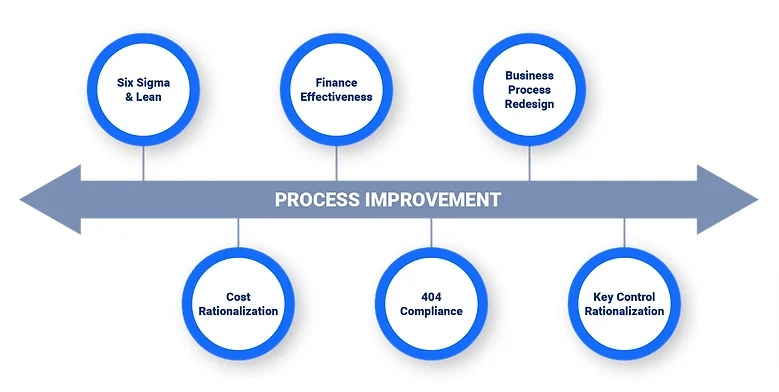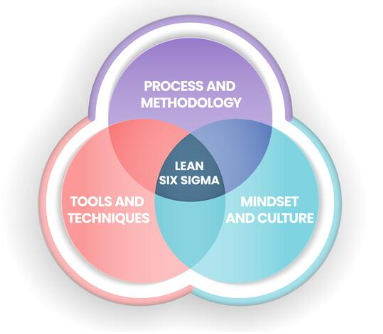
Six Sigma is a data-driven methodology that aims to eliminate defects, reduce variability, and enhance overall process quality. Implementing Six Sigma leads to improved customer satisfaction, increased operational efficiency, and reduced costs. By focusing on customer requirements and minimizing defects, organizations can gain a competitive edge in the market.
At the core of D&V Business Consulting‘s commitment to excellence is the implementation of Six Sigma, a data-driven methodology designed to eliminate defects and enhance overall process quality. It connects the interactions between Lean and Six Sigma, creating a comprehensive and streamlined approach to process enhancement. The combination addresses waste elimination and statistical analysis, ensuring a well-rounded strategy for continuous improvement.
Lean Six Sigma synergizes the strengths of both methodologies. While Six Sigma focuses on statistical analysis and defect reduction, Lean principles address waste elimination, resulting in a more comprehensive and streamlined approach to process improvement.

Lean Six Sigma implementation is data-driven, a business can follow these steps:
- Define the problem and goal: Clearly and precisely state the problem and goal, and determine how success will be measured.
- Collect relevant data: Gather quantitative and qualitative data related to the problem, ensuring that it is reliable, relevant, and actionable.
- Analyze the data: Use data analysis techniques such as systematic examination and statistical methods to identify root causes, measure the impact of process changes, and guide informed decisions.
- Create a data-driven project plan: Develop a detailed project plan based on the analysis, outlining the necessary steps, resources, and timelines for implementing the Lean Six Sigma initiative.
- Monitor and measure progress: Regularly track the performance metrics and progress of the Lean Six Sigma initiative, using data-driven analytics to assess the impact of changes and ensure that the project is on track.
- Validate and verify the results: Confirm the effectiveness of the Lean Six Sigma implementation by using validated and reliable data, ensuring that the decisions are based on factual evidence rather than assumptions.
- Document the results: Maintain records of the project, including the data collected, analyses conducted, and improvements achieved, to facilitate future reference and learning from the experience.
- Train and develop staff: Invest in training and development programs to equip employees with the necessary skills and knowledge to effectively participate in the Lean Six Sigma process, analyze data, and make data-driven decisions.
A business can ensure that its Lean Six Sigma implementation is data-driven, leading to improved processes, increased efficiency, and better business outcomes.

7 Lean Six Sigma Principles
- Define value: Determine the value that customers receive from a product or service and focus on delivering the desired outcomes.
- Map the value stream: Create a visual representation of the entire process, from raw materials to the final product, to identify areas of waste and inefficiency.
- Create flow: Design processes that flow smoothly and efficiently, without unnecessary steps or delays.
- Establish pull: Implement a system for triggering actions when a process is ready to proceed, ensuring that resources are allocated effectively.
- Seek perfection: Continuously strive for improvement by identifying and eliminating the root causes of defects and waste.
- Focus on the customer: Prioritize customer needs and preferences to ensure that products and services meet their expectations.
- Remove causes of defects: Implement measures to prevent defects from occurring in the first place, such as quality control measures and process improvements.

Implementing Lean Six Sigma in a business can bring several benefits, including:
- Increased revenue and profitability: Lean Six Sigma helps organizations to do more with less, enabling them to sell, manufacture, and provide more of what customers want.
- Increased efficiency: Lean Six Sigma creates standard processes that are easy to learn, operate, and enhance, making businesses more scalable and efficient.
- Reduced waste: Lean Six Sigma eliminates unnecessary motion, transportation, inventory, processing, production, and defects, reducing waste and increasing productivity.
- Improved quality: Lean Six Sigma reduces defects and process variation, increasing predictability and consistency, and focusing on those products/processes/services that the customer values most.
- Enhanced customer satisfaction and loyalty: Lean Six Sigma helps businesses to define customers and identify customer requirements, leading to improved customer experience and increased loyalty.
- Improved employee satisfaction and engagement: Lean Six Sigma engages employees in the effort, making them feel more engaged in their jobs, loyal to the company, and better bonded with co-workers.
- Improved risk management and strategic planning: Lean Six Sigma helps businesses to identify and resolve problems earlier, allowing for more cost-effective and efficient operations.
- Improved company culture: Lean Six Sigma is a well-established methodology and has become ingrained within the culture of all organizations that use it, leading to a more positive and productive work environment.
- Attracting business partners: Implementing Lean Six Sigma can lead to more business success, attracting better business partners who want to partner with a successful organization.
The combination of Six Sigma and Lean Six Sigma has become essential for organizations that are aiming to achieve the highest level of operational efficiency.
As more and more success stories are being reported, it is clear that Six Sigma and Lean Six Sigma are not just methods, but rather transformative approaches that lead to long-term growth and success in today’s business environment.
D&V Business Consulting stands at the lead of operational excellence, Six Sigma and Lean Six Sigma to continuously enhance their consulting services. The integration of these methodologies is not merely a strategic decision; it’s a transformative approach that propels D&V business consulting towards sustainable growth and success in the competitive consulting environments.
Related Posts
Lean Management for Indian Businesses: The Impact of an Operational Excellence Consultant
In today’s highly competitive business markets, Indian companies are increasingly turning to lean management principles…
Building a Culture of Continuous Improvement: Tips for Implementing Lean Principles
Continuous Improvement is a key component of lean concepts, which emphasize waste elimination and increased…
 Why Us?
Why Us?  Resources
Resources  Support
Support 










